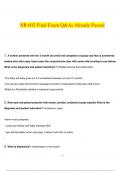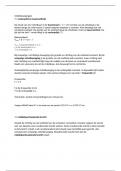Table of Contents
‘Defining the concept of supply chain quality management and its relevance to academic
and industrial practice’......................................................................................................2
‘Learning to evolve; A review of contemporary lean thinking’............................................3
‘Cognition, technology, and organizational limits: Lessons from the Air France 447
disaster’.............................................................................................................................5
‘Management walk-arounds: Lessons from the Gulf of Mexico oil well blowout’................6
‘Bilateral dependency and supplier performance ambiguity in supply chain contracting:
Evidence from the railroad industry’..................................................................................6
‘Examining the Conditional Limits of Relational Governance: Specialized Assets,
Performance Ambiguity, and Long-Standing Ties’..............................................................8
‘Finance and Firm Volatility: Evidence from Small Business Lending in China’.....................9
‘Chapter 6 Supply Chain Finance’........................................................................................9
‘Transaction Cost Economics as a Theory of the Firm, Management, and Governance’.....12
‘Incentives and the efficiency of public sector-outsourcing contracts’...............................13
‘Why locate manufacturing in a high-cost country? A case study of 35 production location
decisions’.........................................................................................................................14
‘Vested outsourcing: a flexible framework for collaborative outsourcing’.........................16
‘Making agency theory work for supply chain relationships: a systematic review across
four disciplines’................................................................................................................18
‘An Agency Theory Investigation of Supply Risk Management’.........................................20
‘Mediation, Arbitration, and Alternative Dispute Resolution (ADR)’.................................21
‘Non-Contractual Relations in Business: A Preliminary Study’...........................................22
‘Supply chain tsunamis: research on low‐probability, high‐impact disruptions’................23
‘Strengthening supply chain resilience during COVID‐19’.................................................26
Case of JD.com and Covid-19........................................................................................................................26
,‘Defining the concept of supply chain quality
management and its relevance to academic and
industrial practice’
Quality practices
- Advance (development) from traditional firm centric and product-based mindsets to
an inter-organizational supply chain orientation involving customers, suppliers, and
other partners.
Organizations that strive to compete on the quality playing field, may pursue quality
initiatives that fail to show real results and sustain competitiveness in the global market,
simply because they fail to communicate precisely what they mean by the term ‘‘quality.’
SCQM
- Formal coordination/ integration of business processes involving all partner
organizations in the supply channel to measure, analyse and continually improve
products, services, and processes to create value and achieve satisfaction of
intermediate/ final customers in the marketplace.
There are a few important aspects to ensure SCQM:
- Communications and partnership activities
Research reinforces concept that strong, structured and mutual supply chain partner
relations result in breaking down the intangible (= ongrijpbaar) characterizations of
quality, and create definitions that support final customer quality
- Process-approach
Quality initiatives can no longer be static and localized, but must interact and
synchronize across the entire network of firms in the supply chain
- Management and leadership
Top management guide/ direct not only individual company efforts but encourage
participation/ quality measurement and performance among all channel members.
Management and leadership imply that management influences relationships and
operations with supply chain partners; knowledge-creating leadership is essential for
globally positioned companies. Organizations must face the reality that they no
longer exist in isolation, but are a piece of a sometimes very intricate supply chain
- Strategy
Specifying means/ activities to realize supply chain opportunities and achieve
competitive advantage.
- Best practices
The use of activities that promote quality in the supply chain framework
SCOR model
- Model illustrates linking of value-adding
processes (VAP) existing in supply chain networks
within a firm’s departments (intra- organizational),
and between firms (inter-organizational).
- Reinforces idea that each linkage and node in the
chain must perform without any disruption to
satisfy final customers.
- Visually demonstrates, only a single weak link in
the supply chain is needed to result in disturbing
, performance such as late deliveries, incomplete order fulfillment, and/or poor product
quality.
Most essential difference in transition of traditional activities from product to process
orientation. Achieving high quality no longer relying solely upon internal resources.
3 significant opportunities for future SCQM research:
1. Encourage process orientation
2. Development of channel quality performance measurements and standards
3. Impact of ISO 9001: looks at effect of quality management on internal company
activities and processes. In many studies the impact up- and downstream of ISO
9001 is unknown.
Review of literature intersecting quality and supply chain research, supports the need for
future research to provide further insights on practices, strategy and performance
measurement revolving around a shift from product-oriented internally driven supply
channel quality management practices to externally focused process-based approaches to
SCQM.
‘Learning to evolve; A review of contemporary lean
thinking’
Lean approach criticised: lack of human integration/ its limited applicability outside high-
volume repetitive manufacturing environments.
Lean thinking includes: just-in-time (JIT) production system, the kanban method of pull
production, respect for employees and high levels of employee problem-solving/automated
mistake proofing.
Relationship between value and cost
Critical point in lean thinking is focus on value. Value creation is often seen as equal to cost
reduction. Represents shortcoming of the understanding of lean. Therefore, relationship
between customer value and cost is examined in detail.
Value needs to be linked to customer requirements, and cannot only be defined through its
opposite, waste, on the shop-floor.
Figure highlights relationship between value and cost. Shows how
products/ services can be plotted regarding their relative cost-
value proposition to the customer.
- Further above cost-value equilibrium a product/service can be
positioned, the more attractive proposition it is to the customers.
- Cost-value equilibrium is the situation whereby product
provides exactly as much value, which the customer is willing to
pay for, as the product costs.
This migration from waste reduction focus to customer value focus opens a second avenue
of value creation:
1. Value is created if internal waste is reduced. Reducing wasteful activities and
associated costs increasing overall value proposition for the customer.
2. Value is also increased, if additional features/ services are offered valued by
customer. Entails shorter delivery cycle/ smaller delivery batches, which not add
additional cost, yet add customer value.
Criticism on lean thinking
‘Defining the concept of supply chain quality management and its relevance to academic
and industrial practice’......................................................................................................2
‘Learning to evolve; A review of contemporary lean thinking’............................................3
‘Cognition, technology, and organizational limits: Lessons from the Air France 447
disaster’.............................................................................................................................5
‘Management walk-arounds: Lessons from the Gulf of Mexico oil well blowout’................6
‘Bilateral dependency and supplier performance ambiguity in supply chain contracting:
Evidence from the railroad industry’..................................................................................6
‘Examining the Conditional Limits of Relational Governance: Specialized Assets,
Performance Ambiguity, and Long-Standing Ties’..............................................................8
‘Finance and Firm Volatility: Evidence from Small Business Lending in China’.....................9
‘Chapter 6 Supply Chain Finance’........................................................................................9
‘Transaction Cost Economics as a Theory of the Firm, Management, and Governance’.....12
‘Incentives and the efficiency of public sector-outsourcing contracts’...............................13
‘Why locate manufacturing in a high-cost country? A case study of 35 production location
decisions’.........................................................................................................................14
‘Vested outsourcing: a flexible framework for collaborative outsourcing’.........................16
‘Making agency theory work for supply chain relationships: a systematic review across
four disciplines’................................................................................................................18
‘An Agency Theory Investigation of Supply Risk Management’.........................................20
‘Mediation, Arbitration, and Alternative Dispute Resolution (ADR)’.................................21
‘Non-Contractual Relations in Business: A Preliminary Study’...........................................22
‘Supply chain tsunamis: research on low‐probability, high‐impact disruptions’................23
‘Strengthening supply chain resilience during COVID‐19’.................................................26
Case of JD.com and Covid-19........................................................................................................................26
,‘Defining the concept of supply chain quality
management and its relevance to academic and
industrial practice’
Quality practices
- Advance (development) from traditional firm centric and product-based mindsets to
an inter-organizational supply chain orientation involving customers, suppliers, and
other partners.
Organizations that strive to compete on the quality playing field, may pursue quality
initiatives that fail to show real results and sustain competitiveness in the global market,
simply because they fail to communicate precisely what they mean by the term ‘‘quality.’
SCQM
- Formal coordination/ integration of business processes involving all partner
organizations in the supply channel to measure, analyse and continually improve
products, services, and processes to create value and achieve satisfaction of
intermediate/ final customers in the marketplace.
There are a few important aspects to ensure SCQM:
- Communications and partnership activities
Research reinforces concept that strong, structured and mutual supply chain partner
relations result in breaking down the intangible (= ongrijpbaar) characterizations of
quality, and create definitions that support final customer quality
- Process-approach
Quality initiatives can no longer be static and localized, but must interact and
synchronize across the entire network of firms in the supply chain
- Management and leadership
Top management guide/ direct not only individual company efforts but encourage
participation/ quality measurement and performance among all channel members.
Management and leadership imply that management influences relationships and
operations with supply chain partners; knowledge-creating leadership is essential for
globally positioned companies. Organizations must face the reality that they no
longer exist in isolation, but are a piece of a sometimes very intricate supply chain
- Strategy
Specifying means/ activities to realize supply chain opportunities and achieve
competitive advantage.
- Best practices
The use of activities that promote quality in the supply chain framework
SCOR model
- Model illustrates linking of value-adding
processes (VAP) existing in supply chain networks
within a firm’s departments (intra- organizational),
and between firms (inter-organizational).
- Reinforces idea that each linkage and node in the
chain must perform without any disruption to
satisfy final customers.
- Visually demonstrates, only a single weak link in
the supply chain is needed to result in disturbing
, performance such as late deliveries, incomplete order fulfillment, and/or poor product
quality.
Most essential difference in transition of traditional activities from product to process
orientation. Achieving high quality no longer relying solely upon internal resources.
3 significant opportunities for future SCQM research:
1. Encourage process orientation
2. Development of channel quality performance measurements and standards
3. Impact of ISO 9001: looks at effect of quality management on internal company
activities and processes. In many studies the impact up- and downstream of ISO
9001 is unknown.
Review of literature intersecting quality and supply chain research, supports the need for
future research to provide further insights on practices, strategy and performance
measurement revolving around a shift from product-oriented internally driven supply
channel quality management practices to externally focused process-based approaches to
SCQM.
‘Learning to evolve; A review of contemporary lean
thinking’
Lean approach criticised: lack of human integration/ its limited applicability outside high-
volume repetitive manufacturing environments.
Lean thinking includes: just-in-time (JIT) production system, the kanban method of pull
production, respect for employees and high levels of employee problem-solving/automated
mistake proofing.
Relationship between value and cost
Critical point in lean thinking is focus on value. Value creation is often seen as equal to cost
reduction. Represents shortcoming of the understanding of lean. Therefore, relationship
between customer value and cost is examined in detail.
Value needs to be linked to customer requirements, and cannot only be defined through its
opposite, waste, on the shop-floor.
Figure highlights relationship between value and cost. Shows how
products/ services can be plotted regarding their relative cost-
value proposition to the customer.
- Further above cost-value equilibrium a product/service can be
positioned, the more attractive proposition it is to the customers.
- Cost-value equilibrium is the situation whereby product
provides exactly as much value, which the customer is willing to
pay for, as the product costs.
This migration from waste reduction focus to customer value focus opens a second avenue
of value creation:
1. Value is created if internal waste is reduced. Reducing wasteful activities and
associated costs increasing overall value proposition for the customer.
2. Value is also increased, if additional features/ services are offered valued by
customer. Entails shorter delivery cycle/ smaller delivery batches, which not add
additional cost, yet add customer value.
Criticism on lean thinking










